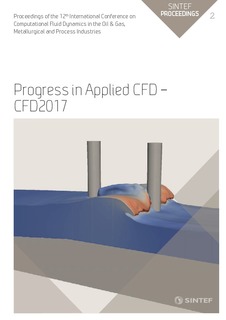| dc.contributor.author | Mihajlovic, Milan | |
| dc.contributor.author | Roghair, Ivo | |
| dc.contributor.author | Annaland, Martin van Sint | |
| dc.date.accessioned | 2017-11-29T06:42:51Z | |
| dc.date.available | 2017-11-29T06:42:51Z | |
| dc.date.issued | 2017 | |
| dc.identifier.isbn | 978-82-536-1544-8 | |
| dc.identifier.issn | 2387-4295 | |
| dc.identifier.uri | http://hdl.handle.net/11250/2468302 | |
| dc.description.abstract | Recent experiments have shown an influence of temperature on the minimum fluidization conditions in gas-solid fluidized beds, even when the gas phase density and viscosity were kept constant (Campos Velarde et al., 2016). Correlations that are available in the open literature, for predicting the minimum fluidization velocity and the bed voidage at minimum fluidization conditions at elevated temperatures, fail to describe their experimental data, in particular how the bed porosity at incipient fluidization conditions is changing with temperature.
It is hypothesized that at higher temperatures inter-particle forces play an important role in this phenomenon. Inter-particle forces, specifically van der Waals forces, are known to be important in the fluidization of very fine powders, and may incur detrimental effects on the process such as the formation of particle agglomerates or reduced particle mixing. However, the experimental results by Campos Velarde et al. (2016) have indicated that such forces may also become important during the fluidization of larger particles at increased temperatures. In this work, we characterize the effects of inter-particle forces using simulations with a Discrete Particle Model (DPM).
DPM is an Euler-Lagrange type model with a discrete description of the solids phase and a continuous description of the gas phase. The motion of each individual particle is tracked and described with Newton’s second law, with van der Waals forces used to describe the inter-particle forces. Van der Waals forces are described with a Hamaker constant, which depends on the particle material and fluidization gas properties and may depend on temperature (Castellanos et al., 2003). Particleparticle interactions are dealt with using a soft-sphere collision model, which allows multiple simultaneous contacts between several pairs of particles. The gas phase is described with a set of volume-averaged Navier-Stokes equations, and full two-way coupling between the phases is implemented.
In this work we investigate the influence of the inter-particle forces (by variation of the Hamaker constant) on the minimum fluidization velocity (Umf) and the bed porosity at minimum fluidization (ɛmf), and relate the effects to the dominating phenomena prevailing at high-temperature fluidization. | nb_NO |
| dc.description.sponsorship | The authors wish to thank the European Commission for supporting this work as part of the research project “Intensified by Design platform for the intensification of processes involving solids handling”, IbD®, under the H2020 SPIRE programme (SPIRE-08-2015-680565). | nb_NO |
| dc.language.iso | eng | nb_NO |
| dc.publisher | SINTEF Academic Press | nb_NO |
| dc.relation.ispartof | Proceedings of the 12th International Conference on Computational Fluid Dynamics in the Oil & Gas, Metallurgical and Process Industries | |
| dc.relation.ispartofseries | SINTEF Proceedings;2 | |
| dc.subject | Discrete particle model | nb_NO |
| dc.subject | Fluidized beds | nb_NO |
| dc.subject | Minimum fluidization | nb_NO |
| dc.subject | Interparticle forces. | nb_NO |
| dc.title | High temperature fluidization ‐ influence of inter‐particle forces on fluidization behavior | nb_NO |
| dc.type | Chapter | nb_NO |
| dc.description.version | publishedVersion | nb_NO |
| dc.rights.holder | SINTEF Academic Press | nb_NO |
| dc.subject.nsi | VDP::Technology: 500 | nb_NO |
| dc.relation.project | EC/H2020/680565 | nb_NO |
